Comprehensive Analysis of Betalain Pigments Using HPLC, UV-Vis & LC-MS
VerifiedAdded on 2023/06/03
|7
|1379
|436
Report
AI Summary
This report provides an overview of betalain pigments and their analysis using various chromatographic and spectroscopic techniques. Betalains, found in Caryophyllales plants, are categorized into betacyanins (red to purple) and betaxanthins (yellow to orange). The report discusses the use of betalains as food dyes and their chemical properties, including the impact of pH on color. It delves into high-performance liquid chromatography (HPLC), UV-Vis spectrophotometry with a calibration curve (SWCC), and liquid chromatography-mass spectrometry (LC-MS), outlining their principles, advantages, and disadvantages in the context of betalain pigment analysis. The report emphasizes the importance of these techniques in identifying and quantifying betalains in various industries, including food processing, cosmetics, and pharmaceuticals. Desklib offers this report and many other study resources for students.
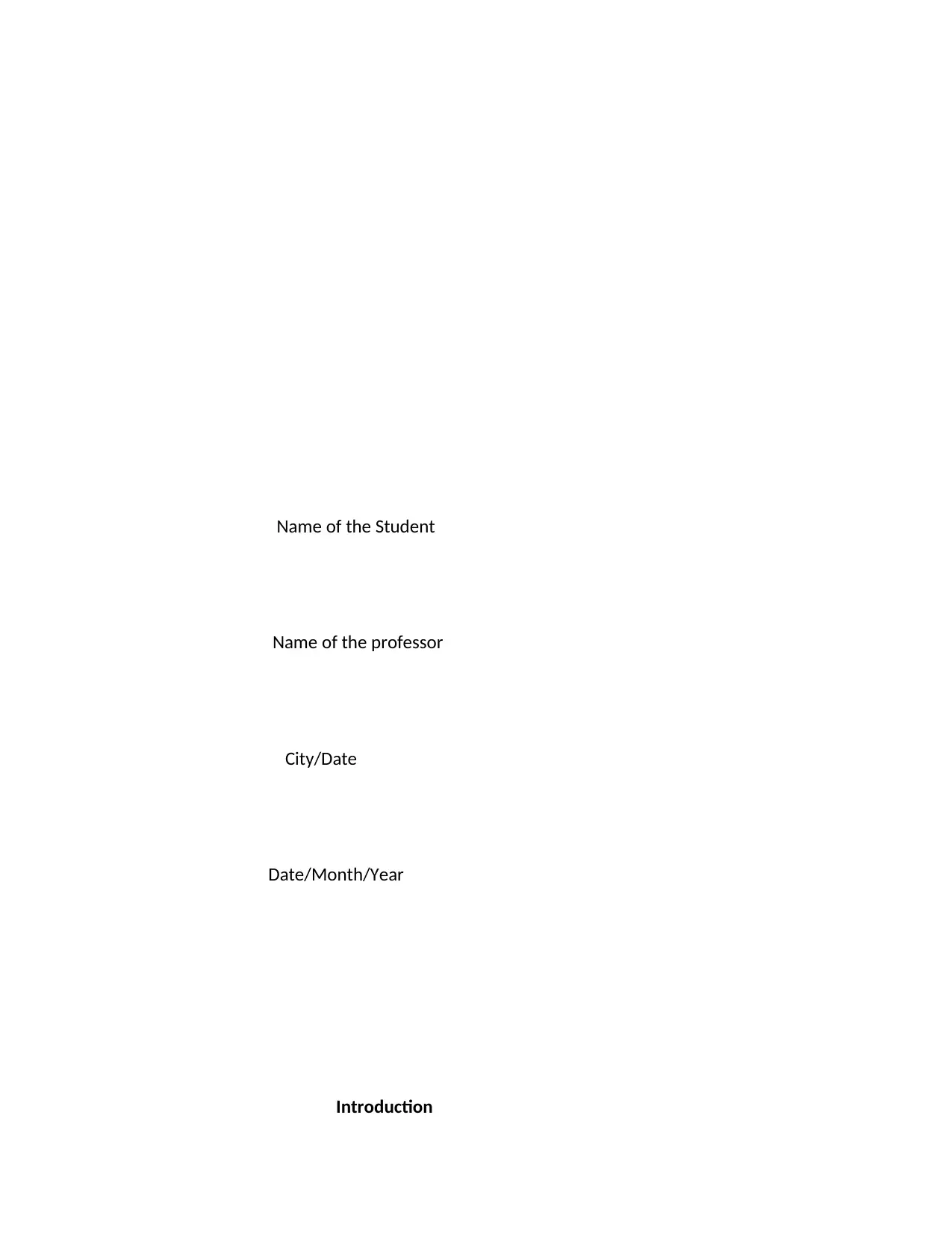
Name of the Student
Name of the professor
City/Date
Date/Month/Year
Introduction
Name of the professor
City/Date
Date/Month/Year
Introduction
Paraphrase This Document
Need a fresh take? Get an instant paraphrase of this document with our AI Paraphraser
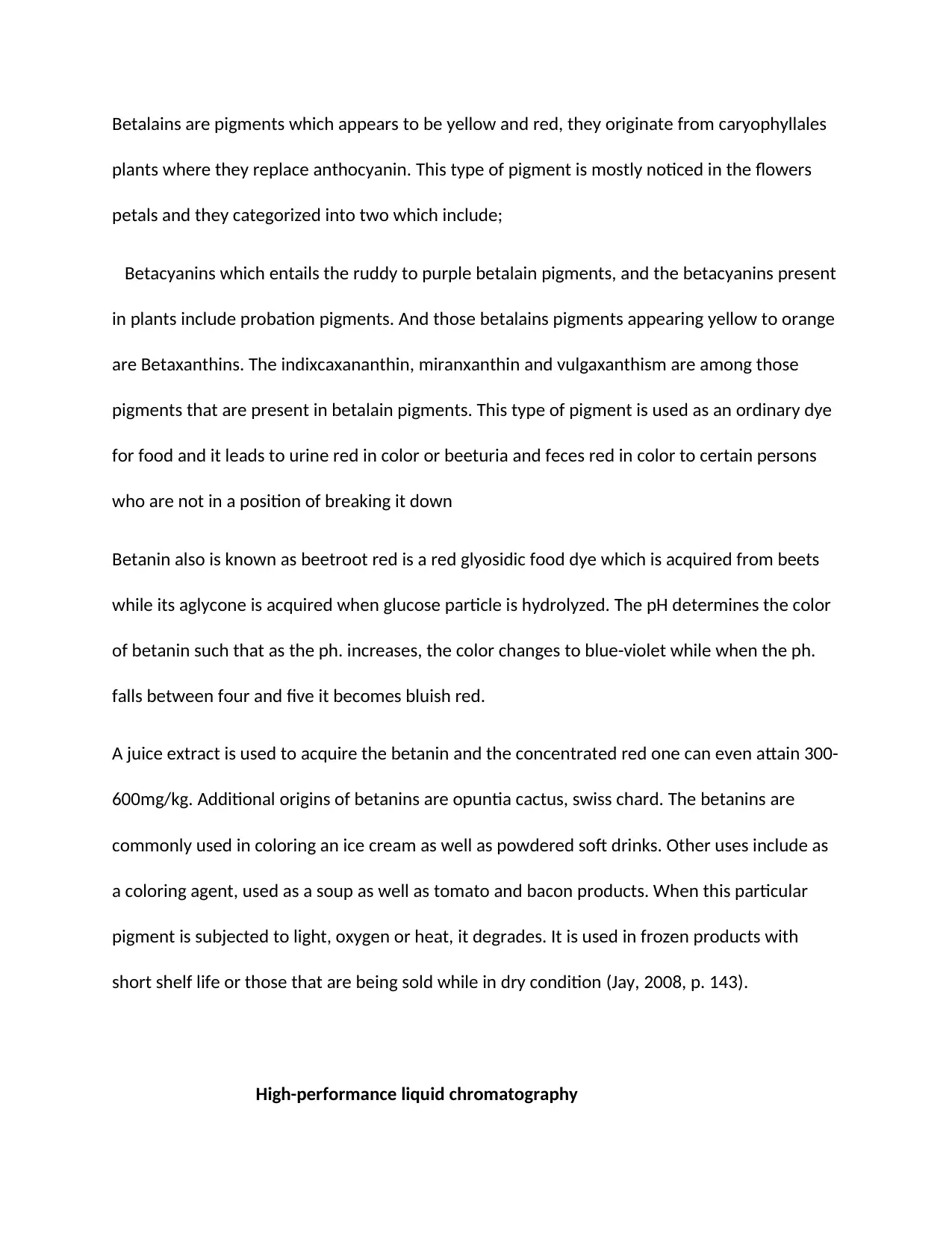
Betalains are pigments which appears to be yellow and red, they originate from caryophyllales
plants where they replace anthocyanin. This type of pigment is mostly noticed in the flowers
petals and they categorized into two which include;
Betacyanins which entails the ruddy to purple betalain pigments, and the betacyanins present
in plants include probation pigments. And those betalains pigments appearing yellow to orange
are Betaxanthins. The indixcaxananthin, miranxanthin and vulgaxanthism are among those
pigments that are present in betalain pigments. This type of pigment is used as an ordinary dye
for food and it leads to urine red in color or beeturia and feces red in color to certain persons
who are not in a position of breaking it down
Betanin also is known as beetroot red is a red glyosidic food dye which is acquired from beets
while its aglycone is acquired when glucose particle is hydrolyzed. The pH determines the color
of betanin such that as the ph. increases, the color changes to blue-violet while when the ph.
falls between four and five it becomes bluish red.
A juice extract is used to acquire the betanin and the concentrated red one can even attain 300-
600mg/kg. Additional origins of betanins are opuntia cactus, swiss chard. The betanins are
commonly used in coloring an ice cream as well as powdered soft drinks. Other uses include as
a coloring agent, used as a soup as well as tomato and bacon products. When this particular
pigment is subjected to light, oxygen or heat, it degrades. It is used in frozen products with
short shelf life or those that are being sold while in dry condition (Jay, 2008, p. 143).
High-performance liquid chromatography
plants where they replace anthocyanin. This type of pigment is mostly noticed in the flowers
petals and they categorized into two which include;
Betacyanins which entails the ruddy to purple betalain pigments, and the betacyanins present
in plants include probation pigments. And those betalains pigments appearing yellow to orange
are Betaxanthins. The indixcaxananthin, miranxanthin and vulgaxanthism are among those
pigments that are present in betalain pigments. This type of pigment is used as an ordinary dye
for food and it leads to urine red in color or beeturia and feces red in color to certain persons
who are not in a position of breaking it down
Betanin also is known as beetroot red is a red glyosidic food dye which is acquired from beets
while its aglycone is acquired when glucose particle is hydrolyzed. The pH determines the color
of betanin such that as the ph. increases, the color changes to blue-violet while when the ph.
falls between four and five it becomes bluish red.
A juice extract is used to acquire the betanin and the concentrated red one can even attain 300-
600mg/kg. Additional origins of betanins are opuntia cactus, swiss chard. The betanins are
commonly used in coloring an ice cream as well as powdered soft drinks. Other uses include as
a coloring agent, used as a soup as well as tomato and bacon products. When this particular
pigment is subjected to light, oxygen or heat, it degrades. It is used in frozen products with
short shelf life or those that are being sold while in dry condition (Jay, 2008, p. 143).
High-performance liquid chromatography
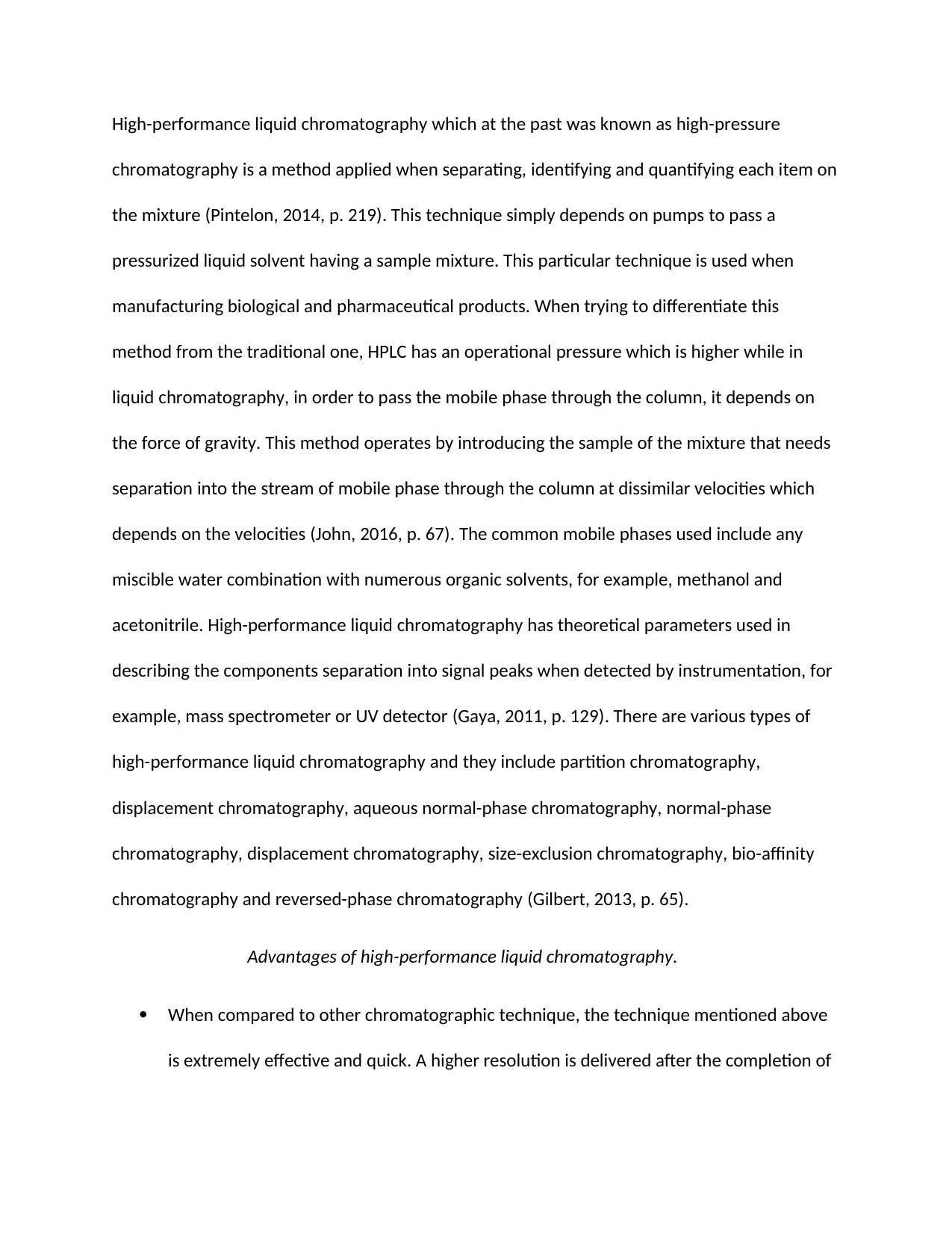
High-performance liquid chromatography which at the past was known as high-pressure
chromatography is a method applied when separating, identifying and quantifying each item on
the mixture (Pintelon, 2014, p. 219). This technique simply depends on pumps to pass a
pressurized liquid solvent having a sample mixture. This particular technique is used when
manufacturing biological and pharmaceutical products. When trying to differentiate this
method from the traditional one, HPLC has an operational pressure which is higher while in
liquid chromatography, in order to pass the mobile phase through the column, it depends on
the force of gravity. This method operates by introducing the sample of the mixture that needs
separation into the stream of mobile phase through the column at dissimilar velocities which
depends on the velocities (John, 2016, p. 67). The common mobile phases used include any
miscible water combination with numerous organic solvents, for example, methanol and
acetonitrile. High-performance liquid chromatography has theoretical parameters used in
describing the components separation into signal peaks when detected by instrumentation, for
example, mass spectrometer or UV detector (Gaya, 2011, p. 129). There are various types of
high-performance liquid chromatography and they include partition chromatography,
displacement chromatography, aqueous normal-phase chromatography, normal-phase
chromatography, displacement chromatography, size-exclusion chromatography, bio-affinity
chromatography and reversed-phase chromatography (Gilbert, 2013, p. 65).
Advantages of high-performance liquid chromatography.
When compared to other chromatographic technique, the technique mentioned above
is extremely effective and quick. A higher resolution is delivered after the completion of
chromatography is a method applied when separating, identifying and quantifying each item on
the mixture (Pintelon, 2014, p. 219). This technique simply depends on pumps to pass a
pressurized liquid solvent having a sample mixture. This particular technique is used when
manufacturing biological and pharmaceutical products. When trying to differentiate this
method from the traditional one, HPLC has an operational pressure which is higher while in
liquid chromatography, in order to pass the mobile phase through the column, it depends on
the force of gravity. This method operates by introducing the sample of the mixture that needs
separation into the stream of mobile phase through the column at dissimilar velocities which
depends on the velocities (John, 2016, p. 67). The common mobile phases used include any
miscible water combination with numerous organic solvents, for example, methanol and
acetonitrile. High-performance liquid chromatography has theoretical parameters used in
describing the components separation into signal peaks when detected by instrumentation, for
example, mass spectrometer or UV detector (Gaya, 2011, p. 129). There are various types of
high-performance liquid chromatography and they include partition chromatography,
displacement chromatography, aqueous normal-phase chromatography, normal-phase
chromatography, displacement chromatography, size-exclusion chromatography, bio-affinity
chromatography and reversed-phase chromatography (Gilbert, 2013, p. 65).
Advantages of high-performance liquid chromatography.
When compared to other chromatographic technique, the technique mentioned above
is extremely effective and quick. A higher resolution is delivered after the completion of
⊘ This is a preview!⊘
Do you want full access?
Subscribe today to unlock all pages.

Trusted by 1+ million students worldwide
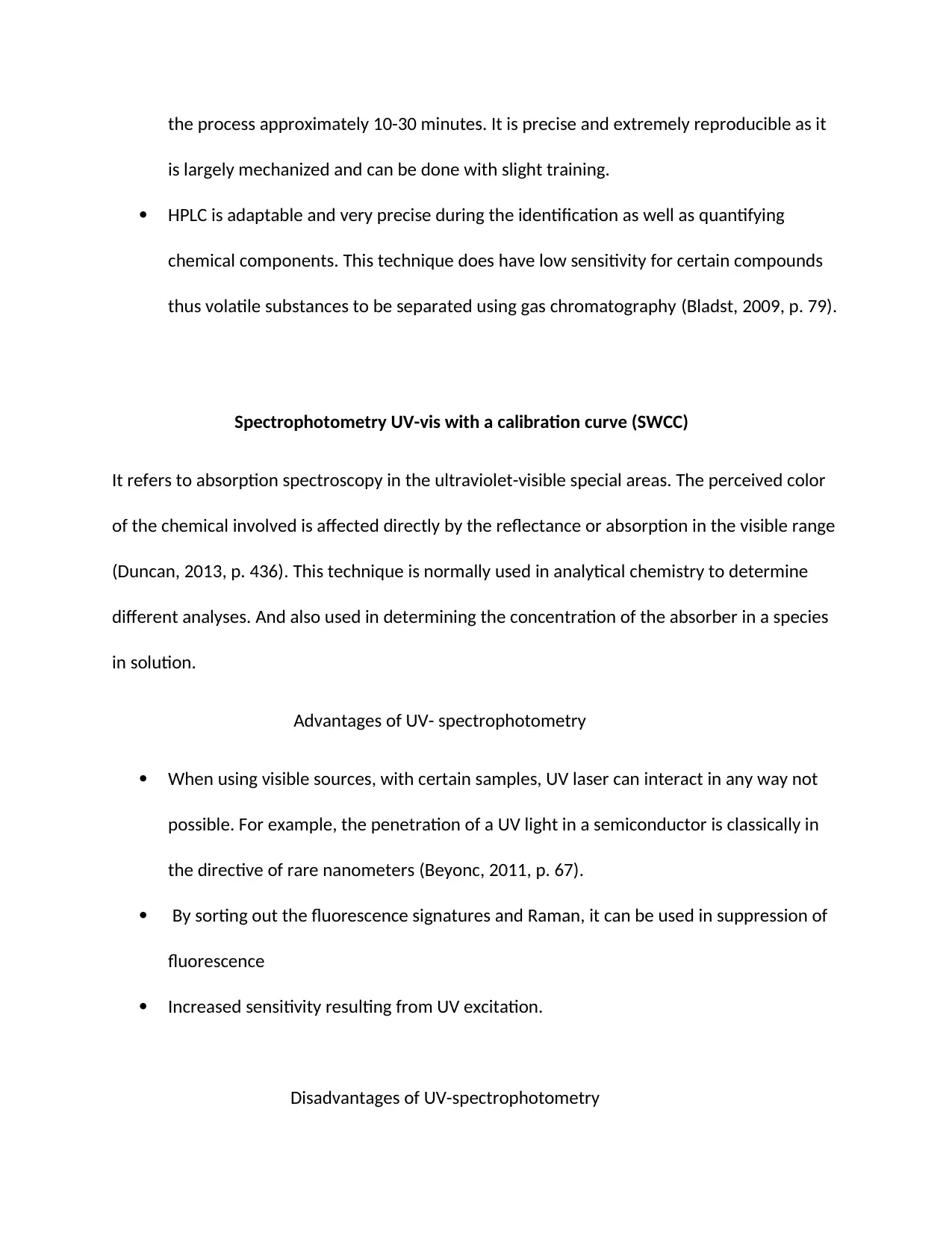
the process approximately 10-30 minutes. It is precise and extremely reproducible as it
is largely mechanized and can be done with slight training.
HPLC is adaptable and very precise during the identification as well as quantifying
chemical components. This technique does have low sensitivity for certain compounds
thus volatile substances to be separated using gas chromatography (Bladst, 2009, p. 79).
Spectrophotometry UV-vis with a calibration curve (SWCC)
It refers to absorption spectroscopy in the ultraviolet-visible special areas. The perceived color
of the chemical involved is affected directly by the reflectance or absorption in the visible range
(Duncan, 2013, p. 436). This technique is normally used in analytical chemistry to determine
different analyses. And also used in determining the concentration of the absorber in a species
in solution.
Advantages of UV- spectrophotometry
When using visible sources, with certain samples, UV laser can interact in any way not
possible. For example, the penetration of a UV light in a semiconductor is classically in
the directive of rare nanometers (Beyonc, 2011, p. 67).
By sorting out the fluorescence signatures and Raman, it can be used in suppression of
fluorescence
Increased sensitivity resulting from UV excitation.
Disadvantages of UV-spectrophotometry
is largely mechanized and can be done with slight training.
HPLC is adaptable and very precise during the identification as well as quantifying
chemical components. This technique does have low sensitivity for certain compounds
thus volatile substances to be separated using gas chromatography (Bladst, 2009, p. 79).
Spectrophotometry UV-vis with a calibration curve (SWCC)
It refers to absorption spectroscopy in the ultraviolet-visible special areas. The perceived color
of the chemical involved is affected directly by the reflectance or absorption in the visible range
(Duncan, 2013, p. 436). This technique is normally used in analytical chemistry to determine
different analyses. And also used in determining the concentration of the absorber in a species
in solution.
Advantages of UV- spectrophotometry
When using visible sources, with certain samples, UV laser can interact in any way not
possible. For example, the penetration of a UV light in a semiconductor is classically in
the directive of rare nanometers (Beyonc, 2011, p. 67).
By sorting out the fluorescence signatures and Raman, it can be used in suppression of
fluorescence
Increased sensitivity resulting from UV excitation.
Disadvantages of UV-spectrophotometry
Paraphrase This Document
Need a fresh take? Get an instant paraphrase of this document with our AI Paraphraser
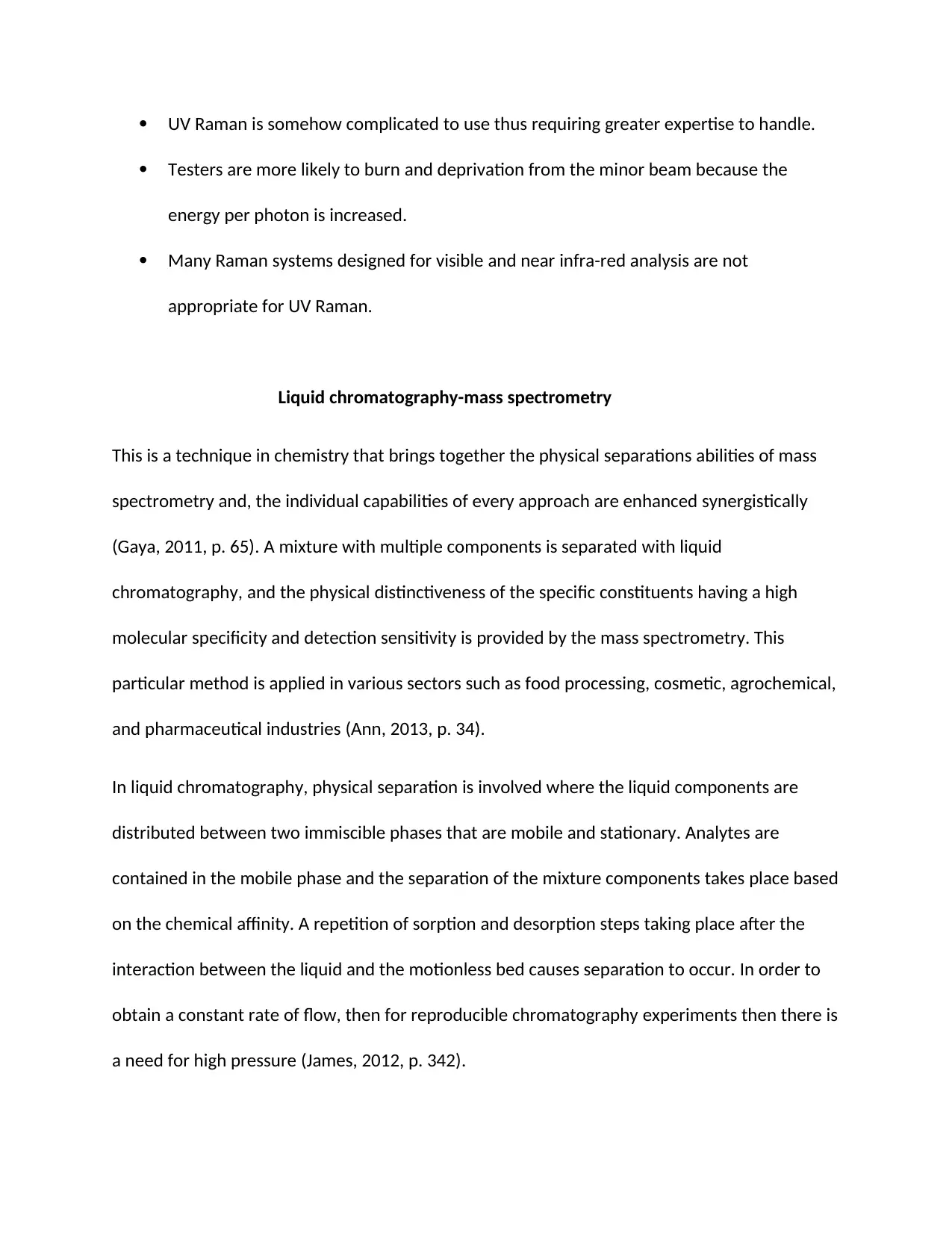
UV Raman is somehow complicated to use thus requiring greater expertise to handle.
Testers are more likely to burn and deprivation from the minor beam because the
energy per photon is increased.
Many Raman systems designed for visible and near infra-red analysis are not
appropriate for UV Raman.
Liquid chromatography-mass spectrometry
This is a technique in chemistry that brings together the physical separations abilities of mass
spectrometry and, the individual capabilities of every approach are enhanced synergistically
(Gaya, 2011, p. 65). A mixture with multiple components is separated with liquid
chromatography, and the physical distinctiveness of the specific constituents having a high
molecular specificity and detection sensitivity is provided by the mass spectrometry. This
particular method is applied in various sectors such as food processing, cosmetic, agrochemical,
and pharmaceutical industries (Ann, 2013, p. 34).
In liquid chromatography, physical separation is involved where the liquid components are
distributed between two immiscible phases that are mobile and stationary. Analytes are
contained in the mobile phase and the separation of the mixture components takes place based
on the chemical affinity. A repetition of sorption and desorption steps taking place after the
interaction between the liquid and the motionless bed causes separation to occur. In order to
obtain a constant rate of flow, then for reproducible chromatography experiments then there is
a need for high pressure (James, 2012, p. 342).
Testers are more likely to burn and deprivation from the minor beam because the
energy per photon is increased.
Many Raman systems designed for visible and near infra-red analysis are not
appropriate for UV Raman.
Liquid chromatography-mass spectrometry
This is a technique in chemistry that brings together the physical separations abilities of mass
spectrometry and, the individual capabilities of every approach are enhanced synergistically
(Gaya, 2011, p. 65). A mixture with multiple components is separated with liquid
chromatography, and the physical distinctiveness of the specific constituents having a high
molecular specificity and detection sensitivity is provided by the mass spectrometry. This
particular method is applied in various sectors such as food processing, cosmetic, agrochemical,
and pharmaceutical industries (Ann, 2013, p. 34).
In liquid chromatography, physical separation is involved where the liquid components are
distributed between two immiscible phases that are mobile and stationary. Analytes are
contained in the mobile phase and the separation of the mixture components takes place based
on the chemical affinity. A repetition of sorption and desorption steps taking place after the
interaction between the liquid and the motionless bed causes separation to occur. In order to
obtain a constant rate of flow, then for reproducible chromatography experiments then there is
a need for high pressure (James, 2012, p. 342).
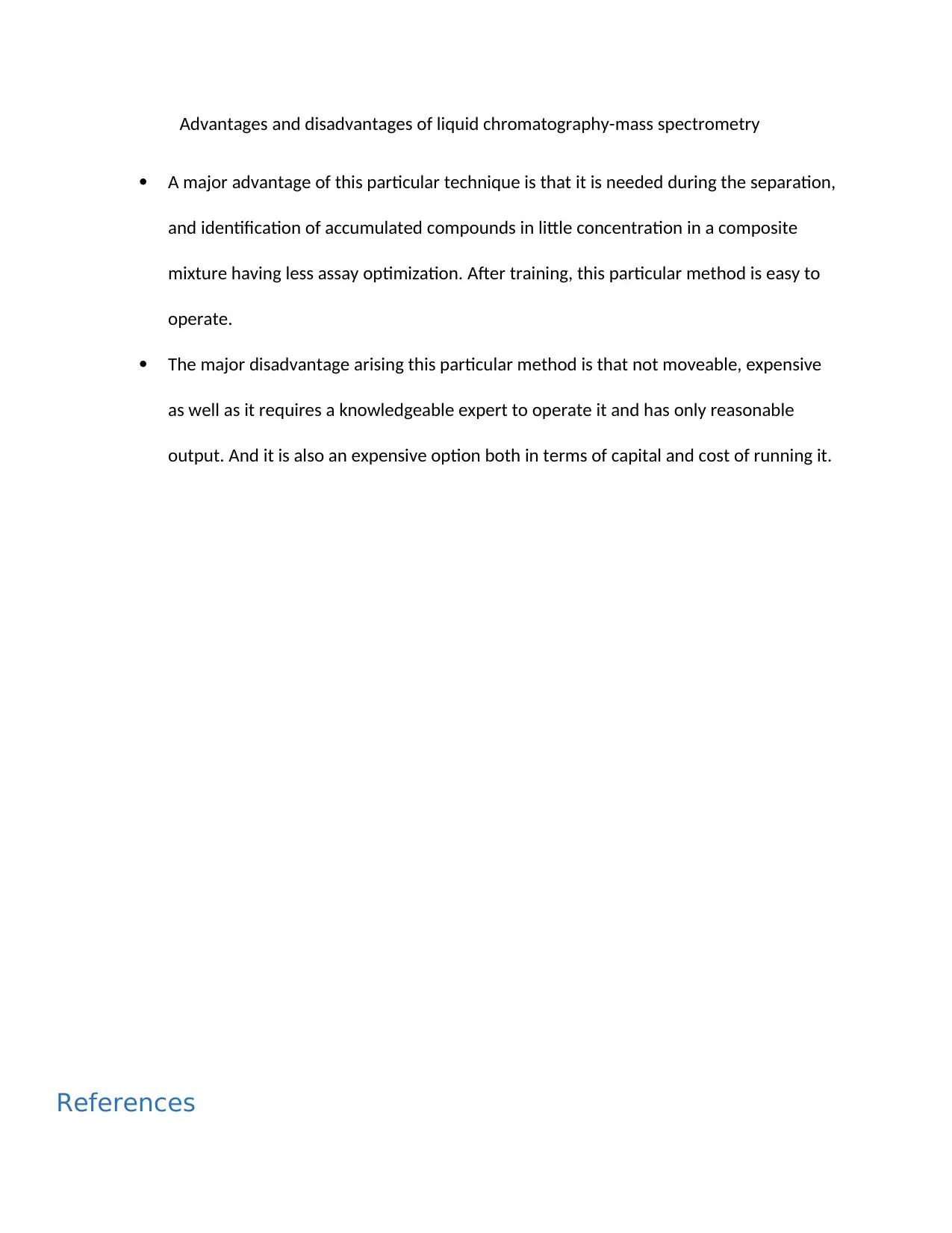
Advantages and disadvantages of liquid chromatography-mass spectrometry
A major advantage of this particular technique is that it is needed during the separation,
and identification of accumulated compounds in little concentration in a composite
mixture having less assay optimization. After training, this particular method is easy to
operate.
The major disadvantage arising this particular method is that not moveable, expensive
as well as it requires a knowledgeable expert to operate it and has only reasonable
output. And it is also an expensive option both in terms of capital and cost of running it.
References
A major advantage of this particular technique is that it is needed during the separation,
and identification of accumulated compounds in little concentration in a composite
mixture having less assay optimization. After training, this particular method is easy to
operate.
The major disadvantage arising this particular method is that not moveable, expensive
as well as it requires a knowledgeable expert to operate it and has only reasonable
output. And it is also an expensive option both in terms of capital and cost of running it.
References
⊘ This is a preview!⊘
Do you want full access?
Subscribe today to unlock all pages.

Trusted by 1+ million students worldwide
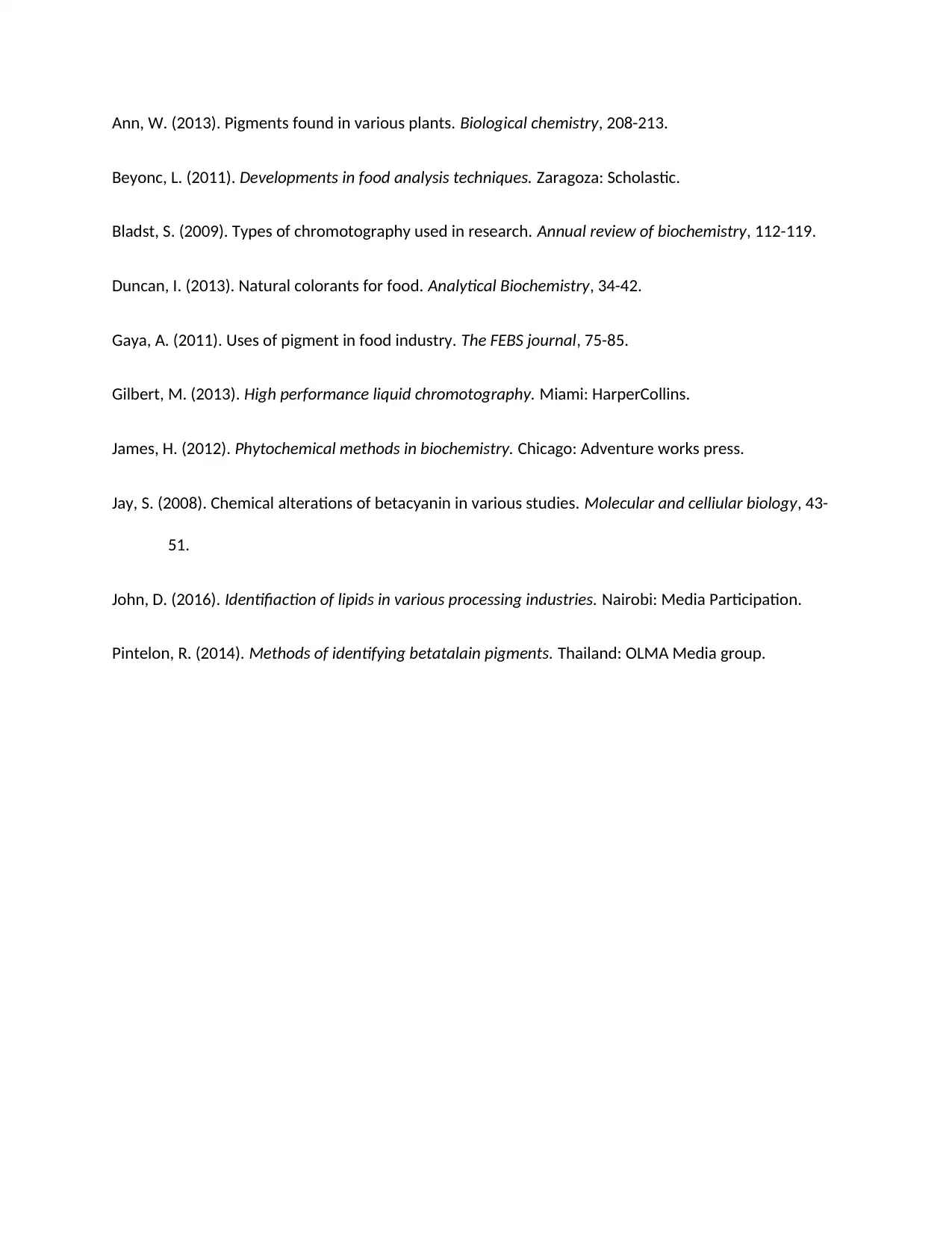
Ann, W. (2013). Pigments found in various plants. Biological chemistry, 208-213.
Beyonc, L. (2011). Developments in food analysis techniques. Zaragoza: Scholastic.
Bladst, S. (2009). Types of chromotography used in research. Annual review of biochemistry, 112-119.
Duncan, I. (2013). Natural colorants for food. Analytical Biochemistry, 34-42.
Gaya, A. (2011). Uses of pigment in food industry. The FEBS journal, 75-85.
Gilbert, M. (2013). High performance liquid chromotography. Miami: HarperCollins.
James, H. (2012). Phytochemical methods in biochemistry. Chicago: Adventure works press.
Jay, S. (2008). Chemical alterations of betacyanin in various studies. Molecular and celliular biology, 43-
51.
John, D. (2016). Identifiaction of lipids in various processing industries. Nairobi: Media Participation.
Pintelon, R. (2014). Methods of identifying betatalain pigments. Thailand: OLMA Media group.
Beyonc, L. (2011). Developments in food analysis techniques. Zaragoza: Scholastic.
Bladst, S. (2009). Types of chromotography used in research. Annual review of biochemistry, 112-119.
Duncan, I. (2013). Natural colorants for food. Analytical Biochemistry, 34-42.
Gaya, A. (2011). Uses of pigment in food industry. The FEBS journal, 75-85.
Gilbert, M. (2013). High performance liquid chromotography. Miami: HarperCollins.
James, H. (2012). Phytochemical methods in biochemistry. Chicago: Adventure works press.
Jay, S. (2008). Chemical alterations of betacyanin in various studies. Molecular and celliular biology, 43-
51.
John, D. (2016). Identifiaction of lipids in various processing industries. Nairobi: Media Participation.
Pintelon, R. (2014). Methods of identifying betatalain pigments. Thailand: OLMA Media group.
1 out of 7
Your All-in-One AI-Powered Toolkit for Academic Success.
+13062052269
info@desklib.com
Available 24*7 on WhatsApp / Email
![[object Object]](/_next/static/media/star-bottom.7253800d.svg)
Unlock your academic potential
Copyright © 2020–2025 A2Z Services. All Rights Reserved. Developed and managed by ZUCOL.

